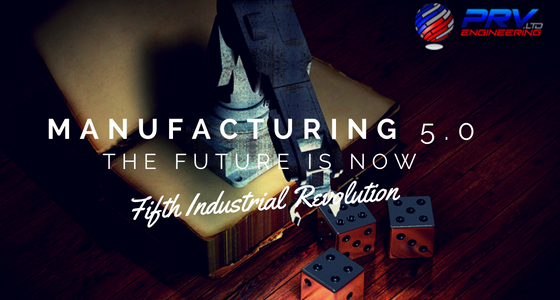While Industry 4.0 is all about automation and digitisation, the future of manufacturing is in personalisation. Manufacturing 5-0, or the Fifth Industrial Revolution, will focus on the co-operation between humans and robots. Although the focus remains on automation and advanced manufacturing, the human element is more important than ever. We’ll take a closer look at what this means for manufacturing but first, let’s recap our journey up to now.
The Road To Manufacturing 5-0
Industry 1.0
Dating back to around 1760, the First Industrial Revolution was the transition to new manufacturing processes using water and steam. While it was hugely beneficial in terms of manufacturing a larger number of various goods and a better standard of living for some, it also resulted in dismal employment and living conditions for the poor and working classes. The textile industry, in particular, was transformed by industrialisation so did transportation.
Industry 2.0
The Second Industrial Revolution was a stage of rapid industrial development, mainly in Britain, Germany and America. During this time, new technological systems were introduced, most notably electrical power and telephones. It allowed for remarkable movement of people and ideas continuing into the 20th century with mass production of goods using assembly lines.
Industry 3.0
Around 1970 saw the Third Industrial Revolution use electronics and IT (Information Technology) to further automation in production. Manufacturing and automation advanced considerably thanks to Internet access, connectivity and renewable energy. Industry 3.0 introduced more robots onto the assembly line to perform human tasks, i.e. using Programmable Logic Controllers (PLC). Although automated systems were in place, they still relied on human input and intervention.
Industry 4.0
The Fourth industrial Revolution is the era of Cyber Physical Systems (CPS). This includes smart machines, storage systems and production facilities that can autonomously exchange information, trigger actions and control each other without human intervention. This exchange of information is made possible with the Industrial Internet of things (IIOT) as we know it today. Key elements of Industry 4.0 include IoT, machine-to-machine communication, cloud computing, 3D printing, AR, VR and advanced cyber security.
What Is Industry 5-0?
The shift from Industry 4.0 to 5.0 means more emphasis on human manufacturers. The Fifth Industrial Revolution will continue to focus more on advanced human-machine interfaces and not on replacing human workers. It combines the best of both worlds; humans and machines working together for improved productivity.
According to visionaries like Esben H. Østergaard, Chief Technology Officer at Universal Robots, Industry 5.0 will re-introduce the human element to manufacturing. While Industry 4.0 focused mainly on technology, robots and interconnected systems, Industry 5-0 looks at people working alongside factory systems.
Human intelligence will work with cognitive computing to produce more value-added goods. Manufacturing 5-0 will allow customers the option to personalise their order. A simple example is how customers can select exactly the kind of shoes or clothing they want. That includes choosing their own colours, style or material before it even goes into production.
This digital transformation of Industry 4.0 means new smart factories with machines connected to the internet. They produce, collect and analyze data across the supply chain to identify ways to drive quality improvement, process optimisation, cost reduction and compliance. Industry 5-0 will combine the accuracy and speed of industrial automation with the critical thinking of human staff members. As a result, technology isn’t replacing people but rather enhances their roles in manufacturing.
Collaborative systems will be responsible for repetitive tasks such as drilling or data mining while staff take on higher-level responsibilities. They will manage and supervise these systems and make real-time decisions looking for opportunities to elevate quality and production processes.
The Introduction Of Collaborative Robots (‘Cobots’)
The formal definition of a cobot is a robot intended to physically interact with humans in a shared workspace. Cobots are different than industrial robots designed to function autonomously and without little to no human intervention.
Cobots have integrated sensors with advanced capabilities and make it possible to automate delicate product assemblies. They work alongside human colleagues greatly improving processes and productivity, helping them complete their work. Not only that, cobots enhance human-based workmanship by increasing speed, accuracy, precision and output. Finely crafted goods with human collaboration really draw attention and cobots can help make that happen but much faster and in greater quantities.
Although industrial robots can cause serious injuries to humans, cobots are designed with safety in mind. If unexpected contact is made with a person, cobots can reduce their speed generating less energy to an extent that prevents injury.
What Does All This Mean?
It’s important to note that Manufacturing 5.0 is an upgrade of 4.0 and not entirely new. Companies still use the technologies of Industry 4.0 but now they will deliver more personalised experiences and offerings. Bringing back the human element into manufacturing means modern technologies will give customers the kind of value-added, human-developed products they desire. At the same time, workers will get more meaningful, valuable and rewarding jobs as a result.
For those fearing the Robot Revolution, it won’t be any time soon and certainly not with cobots. Robots running and staffing a factory on their own remain science-fiction, even in the smart factory of tomorrow. People will remain the core focus while robots and cobots make human jobs less strenuous. They will support humans and give them entirely new capabilities.
How do you think Manufacturing 5-0 will affect your manufacturing plant? How willing are you to embrace the changes and implement the necessary technologies to bring the next Industrial Revolution to your business?
PRV Engineering specialise in a number of industries including construction, automotive, aerospace, rail and steel fabrication. We firmly believe in continuous improvement, investment and innovation with an eye on Manufacturing 5-0 for sure. If you need any assistance with your engineering project, please get in touch.


Recent Comments